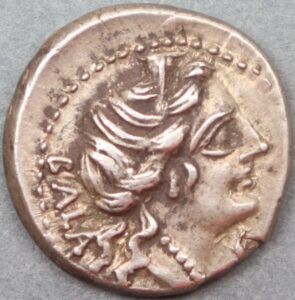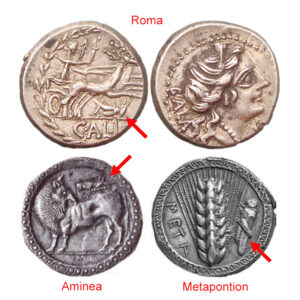Let’s talk about coins and grasshoppers

From a chat with our friend and entomologist, Roberto Scherini, interesting reflections sparked by a coin from the museum emerged. The coin in question is a silver denarius dating back to 92 B.C. with a diademed female head on the obverse, Diana on the reverse and a curious signature by the monetary magistrate C. Alli Bala: a grasshopper!
Man, Orthoptera, art and nature.
The relationships between man and insects, throughout history, have always been many. Evidence of this is the most ancient representation of an insect known so far: a cave cricket, probably attributable to the genus Dolichopoda, engraved on a bison bone in the caves of Trois Frères in the Pyrenees. This engraving was probably made by cavemen during the last Ice Age, between 30,000 and 12,000 years ago. In Italy, the first find of this kind, depicting an orthopterous insect, is a Nuragic bronze statue found in Sardinia in 1873. It is the reproduction of a grasshopper, identifiable with the Saga pedo species, dating back to 2300-3000 years ago. Other representations of orthoptera can be found on ancient coins such as those from the Greek city of Metapontion, in Basilicata (530-510 B.C.) or Aminea in Campania (550-510 B.C). Another interesting find is the Roman coin (92 B.C.) preserved at the Archaeological Museum of the University of Pavia: it depicts Diana, goddess of hunting, on a chariot pulled by deer. She is clutching a sceptre and a torch and has a quiver over her shoulder. In the lower part is a grasshopper, which constitutes the signature (control sign) of the monetary magistrate C. Alli Bala. Art and nature: a perfect combination!
#arte #natura #archeologia #cavallette #monete #moneteromane #numismatica #entomologia #museichiusimuseiaperti #laculturanonsiferma #raccontaMuseo #abbonamentomuseilombardia #LaCulturaCura




